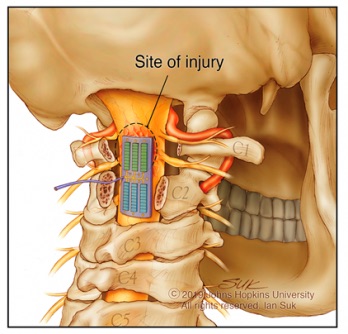
This is an impressive project. Understand that during surgery, it is completely common to cut nerves that then fail to ever heal. Sugeons do their best to avoid this happening but it certainly happens. Thus a device that supports such an injury in such a way that healing becomes possible is to be hoped for.
Military applications are obvious of course. what i am saying is that problem goes far beyond the obvious.
We have been promised the Med Bed, but this work does tackle one of the BIG problems.
Pentagon is Funding Ultrasound Devices That Prevent Tissue Death After Spinal Cord Injuries
https://www.goodnewsnetwork.org/johns-hopkins-spinal-cord-healing-device/
Johns Hopkins is busy on an ambitious development plan for a product that would protect against tissue damage resulting from spinal cord injuries—especially for soldiers who get wounded in the field, but for the public, as well.
The $13.5 million program will aim to develop implantable ultrasound devices that could revolutionize care for the 17,000 Americans who suffer spinal cord injuries every year.
The electronic device is planned to be the size and flexibility of a small Band-Aid and will use high-resolution ultrasound technology to help doctors monitor and treat the changes in blood flow and prevent tissue death that occurs immediately after a traumatic injury to the spinal cord.
The Pentagon’s Defense Advanced Research Projects Agency (DARPA) is fronting the cost for the ultrasound device development to be led by its co-leaders, Nicholas Theodore, M.D., and Amir Manbachi, Ph.D., assistant professors of Neurosurgery and Biomedical Engineering at Johns Hopkins.
“There are few places taking a close look at how engineering approaches could improve the treatment of spinal cord injuries. I think there are tremendous opportunities here,” says Theodore.
Spinal cord injury disrupts the connection between brain and body, causing devastating loss of physiological function, and the money is coming by way of Bridging the Gap Plus which hopes to remove the worst of these injuries specifically for soldiers, who are at a higher risk of spinal cord injuries than civilians.

The new DARPA program combines neurotechnology, artificial intelligence, and biological sensors, to promote healing at the wound site and interfacing with the nervous system at points around the body o restore natural functions such as breathing, bowel and bladder control, movement, touch, and proprioception that can be lost when the spinal cord is damaged.
They have a five-year plan in place that concludes, hopefully, with human trials lying at the end, but a press release from Johns Hopkins notes that research and testing of this kind to bring a product like this to market could take decades with current FDA regulations.
“It is an extraordinary team effort to bring together the smartest engineers and neurosurgeons to solve this problem,” says Theodore. “There are very few places in the world that are able to pull together the resources we have for this project.”
No comments:
Post a Comment